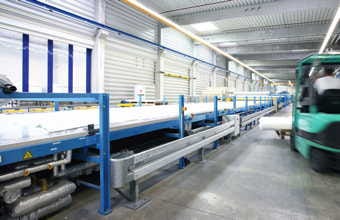Large-surface applications in lightweight vehicle construction are targets for carbon- and glass-fiber composite sheets supplied by Lamilux Heinrich Strunz GmbH (Rehau, Germany).
May 16, 2012
Large-surface applications in lightweight vehicle construction are targets for carbon- and glass-fiber composite sheets supplied by Lamilux Heinrich Strunz GmbH (Rehau, Germany).
|
Composite panels target adoption in truck and trailer panels |
|
Continuous production process enables manufacture of sheeting to exacting specs. |
As inside and outside face sheets of sandwich elements, they reportedly make sidewall and floor constructions of truck components and trailers highly stable and provide them with a long service life along with a very low mass per unit area.
The sheeting, produced in a continuous production process, can be re-ordered at any time with the same mechanical and chemical properties due to the high level of automation in the manufacturing process. The products are marketed under the Lamilux High Strength X-treme and Lamilux High Strength X-treme Carbon brands.
The fibers are arranged in uniaxial, biaxial, triaxial or multiaxial layouts and integrated as fabrics into the composite materials. "The selection of the fiber layout is mainly dependent on the application of the material to be made and the resulting resistance requirements," explains engineer Sascha Oswald, product manager at Lamilux.
In combination with the matrix resin, the fiber fabrics demonstrate very high tensile strength and sturdiness (e-module) in the longitudinal layout of fibers. Says Oswald: "Our high-strength materials are therefore highly suitable for large-surface-area applications in sidewalls, roofs and floors, since they absorb any load and tension forces impacting on the sandwich elements, which make the entire structure very torsion-resistant whilst saving on weight."
Inseparable bond
In Lamilux composites, X-treme stands for the use of a new resin system in which the mixing ratios of epoxy resin, hardeners and additives interact to form a durable composite material with great stability and excellent flexibility in an end product. The result is a matrix material which perfectly encloses the carbon or glass fibers in liquid form before hardening in the production process and forming a high-strength inseparable bond.
All High-Strength-X-treme products also have in common a very high volume of fiber, adds development engineer Matthias Tretter. "In accordance with the mechanical requirements in the area of application, our production process allows us a fiber content of over 70 percent." In addition to the increased resistance and a very low linear-expansion coefficient, this has the advantage of further weight savings with the reduced resin content.
This becomes clear in a comparison between the Lamilux High Strength X-treme Carbon carbon fiber-reinforced material and other materials used in panel facing sheets. Says Tretter: "The CFC we produce is up to 50 percent lighter with a three-to-four-times higher tensile strength in comparison to steel or aluminium."
Large panels; low weight
With Lamilux High Strength X-treme Carbon material, Lamilux is able to produce carbon fiber-reinforced composite material with a width of up to 3.2m in a continuous sheeting manufacturing process. With this composite, the demands of lightweight design for a material with the highest strength and resistance along with a low weight are optimally fulfilled, says Oswald. "The potential of this material lies mainly in the construction of the walls and roofs of light components and trailers." In refrigerated vehicles, the low heat conductivity and the resulting optimized insulation of the refrigerated structure also pays off.
The slightly heavier Lamilux High Strength X-treme, on account of its use of glass-fiber reinforcement, also impresses with its strong resistance to mechanical stresses in utility vehicles. "Due to the high glass content and the resulting low linear expansion, it is particularly suitable for use in lorry roofs," says Oswald. High UV and weathering resistance, as well as the protection from corrosion and hail, are also advantageous.
The composite unfolds its full power in lorry floor assemblies according to its supplier. "Here, Lamilux High Strength X-treme forms the upper or lower face sheet of floor constructions from wood and PU-foam and gives the entire material bond an extremely high flexural strength and torsional stiffness."
In both variants of the composite, a sealing gelcoat allows the UV and weathering resistance of the materials to be increased and gives the surface a high-gloss finish. In addition, colors directly incorporated into the materials are available in all RAL, NCS and customer-specific shades. —[email protected]
About the Author(s)
You May Also Like




